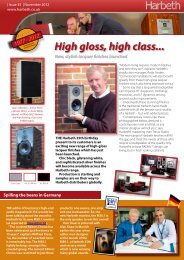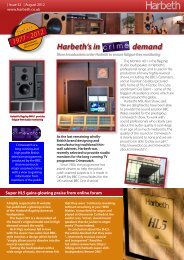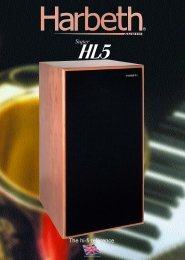AMPLIFIERS, CABLES AND WIRING-UP INTRODUCTION STANDS ...
AMPLIFIERS, CABLES AND WIRING-UP INTRODUCTION STANDS ...
AMPLIFIERS, CABLES AND WIRING-UP INTRODUCTION STANDS ...
You also want an ePaper? Increase the reach of your titles
YUMPU automatically turns print PDFs into web optimized ePapers that Google loves.
Here at Harbeth UK we are dedicated to reproducing the<br />
musicality and warmth of natural sound. With careful use, our<br />
loudspeakers will give you very many years of listening<br />
pleasure, and time will prove your new loudspeakers to be<br />
the ultimate audio investment. I warmly welcome you as a<br />
customer and encourage you to join the Harbeth User Group<br />
(www.harbeth.co.uk) and share your experiences with other<br />
Harbeth owners who, like you, are serious about high fidelity<br />
natural sound.<br />
Alan A. Shaw, Managing Director and Designer, Harbeth UK.<br />
IMPORTANT - LIFTING YOUR NEW<br />
HARBETHS FROM THEIR CARTONS<br />
Before you attempt to lift the speakers from their cartons<br />
please take note of the staples running top to bottom<br />
along one long edge of the carton. Open the carton’s top<br />
flaps, remove the packing cap and take care to avoid<br />
contact between the staples and speaker cabinet. Retain<br />
the packing in a dry place.<br />
<strong>INTRODUCTION</strong><br />
Harbeth loudspeakers are precision instruments. The<br />
cabinets are crafted from a complex interplay of natural and<br />
man made materials, every small detail of which exists for a<br />
specific acoustic purpose. The incredible resolving ability of<br />
the fresh, clean Harbeth sound is the result of high-tech<br />
science combined with traditional craftsmanship. After<br />
exercising your new Harbeths for just a few hours they will be<br />
fully ready for a lifetime of unbeatable performance.<br />
This manual makes a few suggestions for how to extract the<br />
best possible performance from your audio system. Your own<br />
experience must guide you, and what really matters is what<br />
sounds best to you in your room, with your music, your taste<br />
and your equipment. Don’t hesitate to turn to the Harbeth<br />
User Group for help and advice.<br />
Musical appreciation is an ongoing relationship among<br />
performers, recording engineers, equipment designers, you<br />
and your audio dealer. Your dealer is readyt to help you to<br />
get the best from your hi-fi and has the time and the skills to<br />
experiment. Keep an open mind as to new musical avenues,<br />
equipment and accessories. Above all, trust your own ears!<br />
ST<strong>AND</strong>S<br />
Harbeth speakers are at their best when used in ‘free-field’<br />
conditions. This implies that the speakers are raised off the<br />
floor and as far as possible away from adjacent surfaces, on<br />
stands made from a rigid and non-resonant material, such as<br />
wood, filled steel or polymers tubes. If you have children or<br />
animals at home be sure to put safety first as our speakers<br />
are heavy. The top-plate of the stands must be adequately<br />
large and the stands themselves solid and stable<br />
BASIC INSTRUCTIONS, HINTS<br />
<strong>AND</strong> TIPS FOR GETTING THE<br />
BEST FROM YOUR HARBETH<br />
LOUDSPEAKERS<br />
V6 Oct 2012<br />
to prevent the speakers from toppling over and causing<br />
injury or damage.<br />
The cabinet may be attached to the stand’s top-plate with a<br />
small pea-sized ball of “Blu-Tack”, cork or rubber cushioning<br />
dots, cones or spikes. Note: only use the absolute minimum<br />
amount of Blu-Tack as it will permanently bond to the veneer<br />
and cannot be removed. Speaker stands are usually fitted<br />
with sharp spiked feet that further improve stability.<br />
Ideally, the stands should place the tweeter about level with<br />
your ear when seated at your usual listening position — the<br />
so-called ‘reference axis’ — where the frequency response is<br />
optimised. Tall stands lift the speaker farther away from the<br />
floor which adjusts the bass quality but there is always a<br />
compromise involving the aesthetics of tall stands, the<br />
technically ideal listening height and stand stability.<br />
Although the reference listening axis is directly facing the front<br />
baffle, some users prefer both speakers toed-in towards the<br />
listening seat by a few degrees. Adjusting the toe-in alters the<br />
balance especially between the mid and high frequencies in<br />
your room according to your preference.<br />
<strong>AMPLIFIERS</strong>, <strong>CABLES</strong> <strong>AND</strong> <strong>WIRING</strong>-<strong>UP</strong><br />
Harbeths are designed to present an ‘easy’ electrical load to<br />
the amplifier and will work well with valve (tube), solid-state<br />
and digital amplifiers. Playing loudly in a large acoustically dry,<br />
well furnished room will demand a powerful amplifier.<br />
Conversely in a smaller setting listening closer to the<br />
speakers, much less power is needed. As an approximation,<br />
for normal domestic listening an amplifier of about 45W into 8<br />
ohm per channel rating is a good starting point and 100W into<br />
8 ohm per channel would provide a reserve of power for the<br />
louder musical passages if used with care. Be aware that<br />
small amplifiers with limited power output may ‘clip’ when<br />
driven hard and as clipping can damage loudspeaker drive<br />
units it is not covered by our Warranty. The amplifier’s<br />
performance can change over time, and it should ideally be<br />
tested and serviced periodically.<br />
The amplifier’s volume control works much like a zoom lens<br />
and brings the performers closer to you as replay loudness<br />
increases. Every sound recording has an optimum loudness;<br />
not too close and not too far away so that the scale,<br />
perspective, detail and tonal colours are in their correct<br />
proportion. Listening at home at a responsible loudness of<br />
around 85dB is considered a long-term sensible hearing<br />
exposure level by health experts and may be tolerable by<br />
close neighbours. Harbeth speakers are uniquely optimised<br />
to sound full bodied and natural at safe listening levels.<br />
There are many differing views about interconnect and<br />
speaker cables. Your dealer can provide invaluable advice so<br />
we will leave you to explore that and concentrate here on the<br />
basics of hooking-up your loudspeakers. Conventional QEDlike<br />
79-strand cable (or similar) is all you need to get going.<br />
Thin, high resistance cables or exotic cables with a strange<br />
construction may exhibit high capacitance and/or inductance<br />
characteristics and definitely should be avoided as they will<br />
produce unpredictable results and could damage your<br />
amplifier. Where practicable use the same, shortest- possible<br />
cable lengths between amplifier and speakers routed to avoid<br />
the possibility of tripping and pulling the speakers off their<br />
stands. Your dealer will be pleased to make-up and supply<br />
cables at just the right length, terminated with the most<br />
suitable connectors for your equipment and can give you<br />
plenty of advice on cable selection.<br />
The rear terminal panel of your Harbeth speakers carries red<br />
and black coded connectors. Some models feature four<br />
connectors (permitting a bi-wiring connection arrangement)<br />
so the upper pairs are connected internally to the tweeter via<br />
its crossover network and the lower pair to the woofer<br />
through its circuitry. Most models have only one pair of<br />
red/black binding posts. The standard single-wiring<br />
connection method is the simplest, safest and quickest way<br />
of connecting your amplifier, as shown in Setup A.<br />
Reportedly, the so-called 4mm banana plugs commonly used<br />
for connecting speakers to amplifiers can be confused with<br />
overseas two-pin mains plugs. Your dealer will be able to<br />
advise you whether or not 4mm speaker plugs are acceptable<br />
in your country. As an alternative you can use spade<br />
connectors or with care, bare wire ends if the surplus wire is<br />
trimmed off. The signal wire connectors must not touch at any<br />
time or the amplifier may be seriously damaged.<br />
It is extremely important to connect your Harbeths with the<br />
proper phase relationship between the left and right channels<br />
and in bi-wiring/bi-amping configurations additionally between<br />
the woofer and tweeter connections in each speaker. Wiring<br />
your speakers is much simpler if you select a clearly colourcoded<br />
cable where the ‘hot’ (+) or ‘cold’ (-) conductors are<br />
unmistakably identified by colour, rib or printed stripe running<br />
along the sheath. Some cables only have a faint coloured<br />
identifier printed infrequently, so please take care. Incorrect<br />
connections will make natural sound reproduction impossible<br />
and could damage your amplifier. Always recheck the wiring<br />
before powering up the system after making any changes<br />
and look out for fine strands of wire that can stray between<br />
terminals and cause a short circuit.<br />
Never allow a (+) conductor to touch (short) against a (-)<br />
conductor even for a second as some amplifiers cannot<br />
tolerate output short-circuits no matter how briefly.<br />
Safety first!<br />
Turn off your amplifier BEFORE making any changes to<br />
the wiring of your audio system or speakers.<br />
Setup A - Single-wiring (preferred standard method)<br />
Where four-terminals are supplied, the bi-wire links must be<br />
fitted to bridge the speaker’s red-to-red and black-to-black<br />
terminals or where only two terminals are fitted, connect to<br />
your amplifier like this ....<br />
NOTE:<br />
4-terminals are<br />
fitted only to<br />
some models!<br />
Setup B - Bi-wiring for speakers with four rear terminals<br />
First, remove the bi-wire links and connect two pairs of<br />
cables to each speaker. From the amplifier’s red (+) terminal<br />
run two conductors to both of the speaker’s red terminals.<br />
From the amplifier’s black (-) terminal connect to both of the<br />
speaker’s black terminals. You must identify with certainty the<br />
polarity of all the conductors at both ends of the cable to<br />
avoid confusion. Incorrect wiring will result in a short-circuit<br />
with potentially serious consequences for the amplifier.<br />
Bi-amping (not shown) is the most complex arrangement. It<br />
is essential to remove all four bi-wire links before setting-up<br />
for bi-amping which mandates two absolutely identical and<br />
calibrated stereo amplifiers wired so that one complete stereo<br />
amplifier drives each loudspeaker i.e. the amplifier left<br />
channel drives the woofer and the amplifier right channel<br />
drives the tweeter. The wiring is complex and the performance<br />
of the whole system entirely depends on amplifier<br />
characteristics and set-up. Even the smallest variations in<br />
gain between the channels of a normal hi-fi amplifier may be<br />
enough to alter the relative balance between the bass/mid<br />
and high frequencies.<br />
Bi-amping your speakers is specifically excluded from<br />
Harbeth’s Warranty as it requires test equipment to set-up<br />
properly and strict attention to wiring. Your dealer can<br />
provide detailed advice on bi-amping or bi-wiring.<br />
When you have completed your wiring, be sure to route the<br />
speaker cables carefully to prevent anyone tripping over them.<br />
Continued over:…..
HALUG V6z PPX5 Oct. 2012 issued<br />
SPEAKERS IN THE LISTENING ROOM<br />
A sonic compromise has to be reached between positioning<br />
the speakers unobtrusively near walls or positioned farther<br />
out in the listening area. When a loudspeaker is close to a<br />
boundary wall (floor, ceiling or corner) the speaker becomes<br />
‘acoustically coupled’ to the surface, just as if it is actually<br />
attached to it. The speaker then no longer operates in ‘free<br />
space’ with a predictable frequency response but with an<br />
elevated low/mid frequency output that, while not necessarily<br />
unpleasant, adds a lushness to the lower registers. Wellstocked<br />
bookcases behind or beside speakers can greatly<br />
improve the low frequency naturalness as can an<br />
asymmetrical placement of the speakers. Below is an<br />
example of a typical set-up.<br />
Some listeners say that the most natural sound-stage is<br />
achieved when the speakers are slightly closer to each other<br />
than they are away from the listener (above) — please<br />
experiment in your room to see what sounds best.<br />
The ear does not like standing-waves or echoes which you<br />
can identify by moving around your room and loudly clapping<br />
your hands. Parallel surfaces such as opposite walls, floor<br />
and ceiling encourage and sustain problem frequencies and<br />
flexible plasterboard walls and wooden floors over cavities<br />
such as a basement or garage may resonate and cause<br />
boom. Curtains, thick carpets, rugs and bookcases<br />
strategically positioned to minimise reflections in the room<br />
(see picture) can make a dramatic improvement in fidelity.<br />
Pleated curtains on tracks across windows or side walls are<br />
an excellent way of temporarily adjusting room acoustics.<br />
Optimising your speakers in your room needs experimentation<br />
but the general rule is the more absorptive the room, the<br />
less the room influences the sound. Fortunately the ear is<br />
forgiving of all but the most severe room acoustic problems.<br />
Tone controls and modern digital signal processing roomcorrection<br />
systems can, when used carefully, offer a solution<br />
especially in the lower frequencies. In the middle and upper<br />
frequencies conventional soft-fabric treatments are an easy<br />
solution to damping a ‘live’ room.<br />
RECORDINGS - WHAT TO LISTEN FOR<br />
Prepare yourself to hear unexpected details in even your<br />
most cherished recordings that you previously did not realise<br />
were there. A first class recording conjures up a vivid 3D<br />
holographic performance — a curtain of sound — between<br />
and beyond the speakers. Listen out for the way that the<br />
crystalline inner clarity of the Harbeth RADIAL cones<br />
transport you back in time and space to the recording venue.<br />
Be aware that most contemporary commercial recordings<br />
have been sonically processed to enhance their marketability<br />
and that this may be exposed by the greater resolution of<br />
your Harbeth speakers. Certainly many of the most natural<br />
recordings and performances were produced years ago using<br />
simple equipment. Please share your choice of showcase<br />
recordings with us on the Harbeth User Group.<br />
CARE FOR YOUR HARBETHS<br />
To maintain your speakers occasionally wipe over the wood<br />
with a slightly damp cloth rinsed in a dilute detergent suitable<br />
for wood veneer. Do not use waxy polishes. Please avoid<br />
direct sunlight, radiators, draughts, smoke, ozone and other<br />
chemicals on or near the cabinets. The special protective<br />
Harbeth SuperGrilles should be fitted during listening; they<br />
can be cleaned with a soft, dry clean paintbrush. Do not<br />
press or touch the drive units under or through the grille. If<br />
necessary the bass unit can be cleaned with a photographer’s<br />
air-brush, never a cloth. Do not clean the tweeter.<br />
REGISTERING YOUR HARBETHS<br />
Thanks to rigorous quality control in design and during<br />
production, Harbeth speakers will give a long trouble-free<br />
service life if operated at a normal responsible volume level.<br />
The ex-factory Warranty can be extended (subject to<br />
conditions) by Registering your speakers on the Harbeth web<br />
site. Finally, thank you: we wish you many years of great<br />
listening.<br />
Harbeth Audio Ltd.<br />
3-4 Enterprise Park, Lindfield, Haywards Heath,<br />
West Sussex, RH16 2LH, England.<br />
Tel: 01444 484371 www.harbeth.co.uk www.harbeth.co.uk/usergroup






